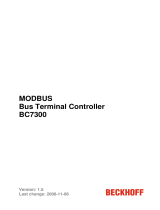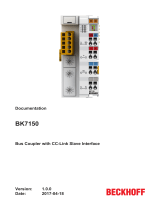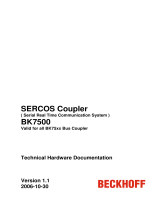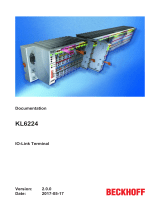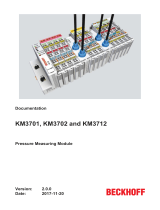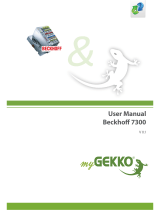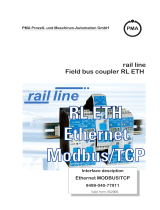Page is loading ...

Documentation
BC9000 and BC9100
Bus Terminal Controller for Ethernet
4.0.0
2019-05-29
Version:
Date:


Table of contents
BC9000 and BC9100 3Version: 4.0.0
Table of contents
1 Foreword ....................................................................................................................................................5
1.1 Notes on the documentation..............................................................................................................5
1.2 Safety instructions .............................................................................................................................6
1.3 Documentation issue status ..............................................................................................................7
2 Product overview.......................................................................................................................................8
2.1 Principle of the Bus Terminal.............................................................................................................8
2.2 The Beckhoff Bus Terminal system...................................................................................................8
2.3 Technical data .................................................................................................................................10
2.4 Technical Data for the PLC .............................................................................................................11
2.5 Ethernet ...........................................................................................................................................11
3 Fitting and wiring.....................................................................................................................................13
3.1 Mechanical installation ....................................................................................................................13
3.1.1 Dimensions ...................................................................................................................... 13
3.1.2 Installation on mounting rails ........................................................................................... 14
3.2 Wiring...............................................................................................................................................15
3.2.1 Power supply, potential groups........................................................................................ 15
3.2.2 Ethernet topologies.......................................................................................................... 17
3.2.3 Ethernet connection......................................................................................................... 19
3.2.4 Ethernet cable.................................................................................................................. 20
4 Parameterization and Commissioning ..................................................................................................22
4.1 Start-up behavior of the Bus Terminal Controller ............................................................................22
4.2 Parameterization of the Bus Coupler using DIP switches ...............................................................22
4.3 Network classes ..............................................................................................................................23
4.4 IP address .......................................................................................................................................24
4.4.1 IP address........................................................................................................................ 24
4.4.2 Configuration with KS2000 .............................................................................................. 24
4.4.3 Setting the IP address using the ARP table..................................................................... 25
4.4.4 Setting the IP Address Using the Beckhoff BootP Server ............................................... 26
4.4.5 Setting the address using a DHCP server ....................................................................... 27
4.4.6 Adressing by name .......................................................................................................... 28
4.4.7 Subnet mask.................................................................................................................... 29
4.4.8 Testing the IP address..................................................................................................... 29
4.4.9 Reading the MAC-ID........................................................................................................ 30
4.4.10 Security settings .............................................................................................................. 30
5 Configuration ...........................................................................................................................................31
5.1 Configuration using the System Manager .......................................................................................31
5.2 The IP Address tab..........................................................................................................................32
5.3 PLC tab............................................................................................................................................33
5.4 Configuration for ModbusTCP .........................................................................................................35
6 Programming ...........................................................................................................................................36
6.1 TwinCAT PLC..................................................................................................................................36
6.2 PLC Cycle Time...............................................................................................................................36
6.3 PLC Variables..................................................................................................................................37

Table of contents
BC9000 and BC91004 Version: 4.0.0
6.4 Mapping the Bus Terminals.............................................................................................................38
6.5 Local process image........................................................................................................................38
6.6 Allocated flag area %MB.. ...............................................................................................................39
6.6.1 Remanent and persistent data......................................................................................... 39
6.6.2 Diagnostics ...................................................................................................................... 40
6.6.3 Cycle Time Measuring ..................................................................................................... 40
6.7 Fieldbus process image...................................................................................................................40
6.7.1 Fieldbus process image................................................................................................... 40
6.7.2 ModbusTCP Process Image............................................................................................ 40
6.7.3 ADS Process Image ........................................................................................................ 41
6.8 Program transfer..............................................................................................................................41
6.8.1 Program transfer via the serial interface.......................................................................... 41
6.8.2 Program Transfer via Ethernet ........................................................................................ 42
6.9 Libraries...........................................................................................................................................45
6.9.1 Libraries ........................................................................................................................... 45
6.9.2 TcUtilitiesBC9000 ............................................................................................................ 46
6.9.3 TcIpUtilitiesBC ................................................................................................................. 49
7 Fieldbus system ......................................................................................................................................51
7.1 Ethernet ...........................................................................................................................................51
7.2 Topology..........................................................................................................................................53
7.3 Reaction times.................................................................................................................................53
7.4 ADS-Communication .......................................................................................................................54
7.4.1 ADS-Communication ....................................................................................................... 54
7.4.2 ADS protocol.................................................................................................................... 55
7.4.3 ADS services ................................................................................................................... 56
7.5 ModbusTCP.....................................................................................................................................64
7.5.1 ModbusTCP Protocol....................................................................................................... 64
7.5.2 Modbus TCP interface ..................................................................................................... 65
7.5.3 ModbusTCP slave error answer (BK9000, BX/BC9xx0, IP/ILxxxx-B/C900, EK9000) ..... 67
7.5.4 ModbusTCP functions ..................................................................................................... 67
7.5.5 Examples for ModbusTCP............................................................................................... 74
7.6 Description of parameters ...............................................................................................................75
7.6.1 Properties of the Bus Terminal Controller........................................................................ 75
8 Error handling and diagnosis.................................................................................................................78
8.1 Diagnostic LEDs ..............................................................................................................................78
8.2 General errors .................................................................................................................................81
8.3 ADS diagnostics ..............................................................................................................................81
8.4 ModbusTCP diagnostic ...................................................................................................................83
9 Appendix ..................................................................................................................................................84
9.1 General operating conditions...........................................................................................................84
9.2 Approvals.........................................................................................................................................85
9.3 Test standards for device testing.....................................................................................................86
9.4 Bibliography.....................................................................................................................................86
9.5 List of Abbreviations ........................................................................................................................86
9.6 Support and Service ........................................................................................................................88

Foreword
BC9000 and BC9100 5Version: 4.0.0
1 Foreword
1.1 Notes on the documentation
Intended audience
This description is only intended for the use of trained specialists in control and automation engineering who
are familiar with the applicable national standards.
It is essential that the documentation and the following notes and explanations are followed when installing
and commissioning these components.
It is the duty of the technical personnel to use the documentation published at the respective time of each
installation and commissioning.
The responsible staff must ensure that the application or use of the products described satisfy all the
requirements for safety, including all the relevant laws, regulations, guidelines and standards.
Disclaimer
The documentation has been prepared with care. The products described are, however, constantly under
development.
We reserve the right to revise and change the documentation at any time and without prior announcement.
No claims for the modification of products that have already been supplied may be made on the basis of the
data, diagrams and descriptions in this documentation.
Trademarks
Beckhoff
®
, TwinCAT
®
, EtherCAT
®
, EtherCATP
®
, SafetyoverEtherCAT
®
, TwinSAFE
®
, XFC
®
and XTS
®
are
registered trademarks of and licensed by Beckhoff Automation GmbH.
Other designations used in this publication may be trademarks whose use by third parties for their own
purposes could violate the rights of the owners.
Patent Pending
The EtherCAT Technology is covered, including but not limited to the following patent applications and
patents: EP1590927, EP1789857, DE102004044764, DE102007017835 with corresponding applications or
registrations in various other countries.
The TwinCAT Technology is covered, including but not limited to the following patent applications and
patents: EP0851348, US6167425 with corresponding applications or registrations in various other countries.
EtherCAT
®
is registered trademark and patented technology, licensed by Beckhoff Automation GmbH,
Germany.
Copyright
© Beckhoff Automation GmbH & Co. KG, Germany.
The reproduction, distribution and utilization of this document as well as the communication of its contents to
others without express authorization are prohibited.
Offenders will be held liable for the payment of damages. All rights reserved in the event of the grant of a
patent, utility model or design.

Foreword
BC9000 and BC91006 Version: 4.0.0
1.2 Safety instructions
Safety regulations
Please note the following safety instructions and explanations!
Product-specific safety instructions can be found on following pages or in the areas mounting, wiring,
commissioning etc.
Exclusion of liability
All the components are supplied in particular hardware and software configurations appropriate for the
application. Modifications to hardware or software configurations other than those described in the
documentation are not permitted, and nullify the liability of Beckhoff Automation GmbH & Co. KG.
Personnel qualification
This description is only intended for trained specialists in control, automation and drive engineering who are
familiar with the applicable national standards.
Description of instructions
In this documentation the following instructions are used.
These instructions must be read carefully and followed without fail!
DANGER
Serious risk of injury!
Failure to follow this safety instruction directly endangers the life and health of persons.
WARNING
Risk of injury!
Failure to follow this safety instruction endangers the life and health of persons.
CAUTION
Personal injuries!
Failure to follow this safety instruction can lead to injuries to persons.
NOTE
Damage to environment/equipment or data loss
Failure to follow this instruction can lead to environmental damage, equipment damage or data loss.
Tip or pointer
This symbol indicates information that contributes to better understanding.

Foreword
BC9000 and BC9100 7Version: 4.0.0
1.3 Documentation issue status
Version Modifications
4.0 • Migration
3.12 • HTML documentation for firmware versions from BB (BC9000) and B1 (BC9100)
3.11 • HTML documentation for firmware versions from BB (BC9000) and B1 (BC9100)
3.10 • HTML documentation; valid as from firmware BA
3.9 • HTML documentation; valid as from firmware B9
3.8 • HTML documentation; valid as from firmware B8
Firmware BC9000/BC9100
You can determine which firmware was fitted when the Bus Coupler left the factory from the adhesive label
underneath (see the fifth and sixth figures of the production number).
Example:
3200B2020000
The firmware in the example is B2.
In order to update your firmware, you require the KS2000 configuration software and the serial cable
included with that software; as from software version B6, you can update your coupler using the TwinCAT
2.8 system manager. You will find the firmware under www.beckhoff.de.
Firmware Description
BB (BC9000)
B1 (BC9100)
• Restructuring of the internal Ethernet communication
• Adjustment of the cycle tick counter to 1ms per tick
BA • Variable size increased from 6kbyte to 16kbyte
• Data storage in flash memory [}59]
• SNTP/Time Protocol implemented
• Access via name resolution
• Optimization: 25% performance increase through code optimization
B9 Error in the B8 version related to mapping the KL60xx Bus Terminals corrected
B8 Internal software reset modified (this does not have any effects that concern the user)
B7 • Settings such as the IP address are retained during a firmware update
• ADS indication function block implemented
• ADS "State" supported
• DHCP for "Nortel Switch" modified
• Cycle time monitoring
• Fast ModbusTCP implemented
B6 • Implementation of the ModbusTCP, ADS, SMTP and IP-Config function blocks
• Firmware update over Ethernet possible
• Reading out the configuration with the System Manager (as from TwinCAT 2.8) possible
• ADS access control through table 2 implemented
B5 • Addressing via ARP and BootP possible
• Access to the flags area via ModbusTCP
B3 Implementation of ModbusTCP
B2 • Problems with the ASC/CHR functions corrected
• The fault which caused error code 1 to be generated after TwinCAT starts up was
corrected
• Implementation of PLCSystemBC.lb6
B1 Released version
B0 Preliminary version

Product overview
BC9000 and BC91008 Version: 4.0.0
2 Product overview
2.1 Principle of the Bus Terminal
Fig.1: Principle of the Bus Terminal
2.2 The Beckhoff Bus Terminal system
Up to 256 Bus Terminals, with 1 to 16I/O channels per signal form
The Bus Terminal system is the universal interface between a fieldbus system and the sensor / actuator
level. A unit consists of a Bus Coupler as the head station, and up to 64 electronic series terminals, the last
one being an end terminal. Up to 255 Bus Terminals can be connected via the K-bus extension. For each
technical signal form, terminals are available with one, two, four or eight I/O channels, which can be mixed
as required. All the terminal types have the same mechanical construction, so that difficulties of planning and
design are minimized. The height and depth match the dimensions of compact terminal boxes.
Decentralised wiring of each I/O level
Fieldbus technology allows more compact forms of controller to be used. The I/O level does not have to be
brought to the controller. The sensors and actuators can be wired decentrally, using minimum cable lengths.
The controller can be installed at any location within the plant.
Industrial PCs as controllers
The use of an Industrial PC as the controller means that the operating and observing element can be
implemented in the controller's hardware. The controller can therefore be located at an operating panel, in a
control room, or at some similar place. The Bus Terminals form the decentralised input/output level of the

Product overview
BC9000 and BC9100 9Version: 4.0.0
controller in the control cabinet and the subsidiary terminal boxes. The power sector of the plant is also
controlled over the bus system in addition to the sensor/actuator level. The Bus Terminal replaces the
conventional series terminal as the wiring level in the control cabinet. The control cabinet can have smaller
dimensions.
Bus Couplers for all usual bus systems
The Beckhoff Bus Terminal system unites the advantages of a bus system with the possibilities of the
compact series terminal. Bus Terminals can be driven within all the usual bus systems, thus reducing the
controller parts count. The Bus Terminals then behave like conventional connections for that bus system. All
the performance features of the particular bus system are supported.
Mounting on standardized mounting rails
The installation is standardized thanks to the simple and space-saving mounting on a standardized mounting
rail (EN60715, 35mm) and the direct wiring of actuators and sensors, without cross connections between
the terminals. The consistent labelling scheme also contributes.
The small physical size and the great flexibility of the Bus Terminal system allow it to be used wherever a
series terminal is also used. Every type of connection, such as analog, digital, serial or the direct connection
of sensors can be implemented.
Modularity
The modular assembly of the terminal strip with Bus Terminals of various functions limits the number of
unused channels to a maximum of one per function. The presence of two channels in one terminal is the
optimum compromise of unused channels and the cost of each channel. The possibility of electrical isolation
through potential feed terminals also helps to keep the number of unused channels low.
Display of the channel state
The integrated LEDs show the state of the channel at a location close to the sensors and actuators.
K-bus
The K-bus is the data path within a terminal strip. The K-bus is led through from the Bus Coupler through all
the terminals via six contacts on the terminals' side walls. The end terminal terminates the K-bus. The user
does not have to learn anything about the function of the K-bus or about the internal workings of the
terminals and the Bus Coupler. Many software tools that can be supplied make project planning,
configuration and operation easy.
Potential feed terminals for isolated groups
The operating voltage is passed on to following terminals via three power contacts. You can divide the
terminal strip into arbitrary isolated groups by means of potential feed terminals. The potential feed terminals
play no part in the control of the terminals, and can be inserted at any locations within the terminal strip.
Up to 64Bus Terminals can be used in a terminal block, with optional K-bus extension for up to 256Bus
Terminals. This count does include potential feed terminals, but not the end terminal.
Bus Couplers for various fieldbus systems
Various Bus Couplers can be used to couple the electronic terminal strip quickly and easily to different
fieldbus systems. It is also possible to convert to another fieldbus system at a later time. The Bus Coupler
performs all the monitoring and control tasks that are necessary for operation of the connected Bus
Terminals. The operation and configuration of the Bus Terminals is carried out exclusively by the Bus
Coupler. Nevertheless, the parameters that have been set are stored in each Bus Terminal, and are retained
in the event of voltage drop-out. Fieldbus, K-bus and I/O level are electrically isolated.
If the exchange of data over the fieldbus is prone to errors or fails for a period of time, register contents (such
as counter states) are retained, digital outputs are cleared, and analog outputs take a value that can be
configured for each output when commissioning. The default setting for analog outputs is 0 V or 0 mA. Digital

Product overview
BC9000 and BC910010 Version: 4.0.0
outputs return in the inactive state. The timeout periods for the Bus Couplers correspond to the usual
settings for the fieldbus system. When converting to a different bus system it is necessary to bear in mind the
need to change the timeout periods if the bus cycle time is longer.
The interfaces
A Bus Coupler has six different methods of connection. These interfaces are designed as plug connectors
and as spring-loaded terminals.
2.3 Technical data
Fig.2: BC9000 and BC9100
System data Ethernet (BC9000) Ethernet (BC9100)
Number of I/O modules only limited by the IP address space
Number of I/O points depending on controller
Data transfer medium 4 x 2 twisted-pair copper cables; category 3 (10 Mbit/s), category 5 (100Mbit/s)
Distance between
modules
100 m (distributor hub to BC9000) Line: max. 100m between two BC9100
Data transfer rate 10 / 100 Mbit/s
Topology star wiring star wiring, up to 20 BC9100 in one line

Product overview
BC9000 and BC9100 11Version: 4.0.0
Technical data BC9000 BC9100
Number of Bus Terminals 64
Digital peripheral signals 256 inputs/outputs
Analog peripheral signals 128 inputs/outputs
Protocols Beckhoff ADS, ModbusTCP
Configuration possibility via the KS2000 configuration software or the controller (TwinCAT)
Maximum number of bytes 512bytes I and 512bytes O
Bus connection 1 x RJ 45 2 x RJ45
Internal switch - 3-port switch (two external connections)
Power supply 24V
DC
(-15%/+20%)
Input current 70mA + (total K-bus current)/4
Starting current approx. 2.5 x continuous current
Recommended fuse ≤10A
K-Bus power supply up to 1750mA
Power contact voltage max. 24V
DC
Power contact current load 10A max.
Dielectric strength 500V (power contact/supply voltage/fieldbus)
Weight approx. 170g
Operating temperature -25°C ... +60°C
Storage temperature -40°C...+85°C
Relative humidity 95% no condensation
Vibration/shock resistance conforms to IEC 68-2-6 / IEC 68-2-27
EMC immunity/emission conforms to EN 50082 (ESD, burst) / EN 50081
Mounting position variable
Protection class IP20
2.4 Technical Data for the PLC
PLC data BC9000 BC9100
Programmability via programming interface (TwinCAT) or via Ethernet (TwinCAT)
Program memory 64/96kbyte
Data memory 64/128kbyte
Remanent flags 4kbyte
PLC cycle time Approx. 1.5ms for 1000 IL commands
(without I/O cycle)
Approx. 1.2ms for 1000 IL commands
(without I/O cycle)
Programming languages IEC 6-1131-3 (IL, LD, FBD, ST, SFC)
2.5 Ethernet
Ethernet was originally developed by DEC, Intel and XEROX (as the "DIX" standard) for passing data
between office devices. The term nowadays generally refers to the IEEE802.3 CSMA/CD specification,
published in 1985. Because of the high acceptance around the world this technology is available everywhere
and is very economical. This means that it is easy to make connections to existing networks.
There are now a number of quite different transmission media: coaxial cable (10Base5), optical fiber
(10BaseF) or twisted pairs (10BaseT) with screen (STP) or without screen (UTP). Using Ethernet, different
topologies can be built such as ring, line or star.
Ethernet transmits Ethernet packets from a sender to one or more receivers. This transmission takes place
without acknowledgement, and without the repetition of lost packets. To achieve reliable data
communication, there are protocols, such as TCP/IP, that can run on top of Ethernet.

Product overview
BC9000 and BC910012 Version: 4.0.0
Basic principles
The Internet Protocol (IP)
The internet protocol (IP) forms the basis of this data communication. IP transports data packets from one
device to another; the devices can be in the same network, or in different networks. IP here looks after the
address management (finding and assigning MAC-IDs), segmentation and routing. Like the Ethernet
protocol, IP does not guarantee that the data is transported - data packets can be lost, or their sequence can
be changed.
TCP/IP was developed to provide standardised, reliable data exchange between any numbers of different
networks. TCP/IP was developed to provide standardised, reliable data exchange between any numbers of
different networks. Although the term is often used as if it were a single concept, a number of protocols are
layered together: e.g. IP, TCP, UDP, ARP and ICMP.
Transmission Control Protocol (TCP)
The Transmission Control Protocol (TCP) which runs on top of IP is a connection-oriented transport protocol.
It includes error detection and handling mechanisms. Lost telegrams are repeated.
User Datagram Protocol (UDP)
UDP is connectionless transport protocol. It provides no control mechanism when exchanging data between
sender and receiver. This results in a higher processing speed than, for example, TCP. Checking whether or
not the telegram has arrived must be carried out by the higher-level protocol.
Internet Control Message Protocol (ICMP)
It is used by end devices, to exchange information about the current status of the internet protocol.
Address Resolution Protocol (ARP)
Performs conversion between the IP addresses and MAC addresses.
BootP
The BootP protocol allows the TCP/IP address to be set or altered, by addressing the network device with its
MAC-ID.

Fitting and wiring
BC9000 and BC9100 13Version: 4.0.0
3 Fitting and wiring
3.1 Mechanical installation
3.1.1 Dimensions
The system of the Beckhoff Bus Terminals is characterized by low physical volume and high modularity.
When planning a project it must be assumed that at least one Bus Coupler and a number of Bus Terminals
will be used. The mechanical dimensions of the Bus Couplers are independent of the fieldbus system.
Fig.3: Dimensions
The total width in practical cases is composed of the width of the Bus Coupler, the KL9010 Bus End
Terminal and the width of the bus terminals in use. Depending on function, the Bus Terminals are 12mm or
24mm wide. The front wiring increases the total height of 68mm by about 5mm to 10mm, depending on
the wire thickness.

Fitting and wiring
BC9000 and BC910014 Version: 4.0.0
3.1.2 Installation on mounting rails
WARNING
Risk of injury through electric shock and damage to the device!
Bring the Bus Terminals system into a safe, de-energized state before starting mounting, disassembly or
wiring of the Bus Terminals.
Mounting
The Bus Couplers and Bus Terminals are attached to commercially available 35mm mounting rails (DIN rail
according to EN60715) by applying slight pressure:
1. First attach the Fieldbus Coupler to the mounting rail.
2. The Bus Terminals are now attached on the right-hand side of the fieldbus Coupler. Join the compo-
nents with slot and key and push the terminals against the mounting rail, until the lock clicks onto the
mounting rail.
If the terminals are clipped onto the mounting rail first and then pushed together without tongue and
groove, the connection will not be operational! When correctly assembled, no significant gap should
be visible between the housings.
Fixing of mounting rails
The locking mechanism of the terminals and couplers extends to the profile of the mounting rail. At
the installation, the locking mechanism of the components must not come into conflict with the fixing
bolts of the mounting rail. To mount the mounting rails with a height of 7.5mm under the terminals
and couplers, you should use flat mounting connections (e.g. countersunk screws or blind rivets).
Disassembly
Each terminal is secured by a lock on the mounting rail, which must be released for disassembly:
1. Carefully pull the orange-colored lug approximately 1cm out of the terminal to be disassembled, until
it protrudes loosely. The lock with the mounting rail is now released for this terminal, and the terminal
can be pulled from the mounting rail without excessive force.
2. Grasp the released terminal with thumb and index finger simultaneous at the upper and lower grooved
housing surfaces and pull the terminal away from the mounting rail.
Connections within a Bus Terminal block
The electric connections between the Bus Coupler and the Bus Terminals are automatically realized by
joining the components:
• The six spring contacts of the K-Bus/E-Bus deal with the transfer of the data and the supply of the Bus
Terminal electronics.
• The power contacts deal with the supply for the field electronics and thus represent a supply rail within
the Bus Terminal block. The power contacts are supplied via terminals on the Bus Coupler.
Power contacts
During the design of a Bus Terminal block, the pin assignment of the individual Bus Terminals must
be taken account of, since some types (e.g. analog Bus Terminals or digital 4-channel Bus Termi-
nals) do not or not fully loop through the power contacts. Power Feed Terminals (KL91xx, KL92xx
and EL91xx, EL92xx) interrupt the power contacts and thus represent the start of a new supply rail.
PE power contact
The power contact labelled PE can be used as a protective earth. For safety reasons this contact mates first
when plugging together, and can ground short-circuit currents of up to 125A.

Fitting and wiring
BC9000 and BC9100 15Version: 4.0.0
NOTE
Risk of damage to the device
Note that, for reasons of electromagnetic compatibility, the PE contacts are capacitatively coupled to the
mounting rail. This may lead to incorrect results during insulation testing or to damage on the terminal (e.g.
disruptive discharge to the PE line during insulation testing of a consumer with a nominal voltage of 230V).
For insulation testing, disconnect the PE supply line at the Bus Coupler or the Power Feed Terminal! In or-
der to decouple further feed points for testing, these Power Feed Terminals can be released and pulled at
least 10mm from the group of terminals.
WARNING
Risk of electric shock!
The PE power contact must not be used for other potentials!
Wiring
Up to eight connections enable the connection of solid or finely stranded cables to the Bus Terminals. The
terminals are implemented in spring force technology. Connect the cables as follows:
1. Open a spring-loaded terminal by slightly pushing with a screwdriver or a rod into the square opening
above the terminal.
2. The wire can now be inserted into the round terminal opening without any force.
3. The terminal closes automatically when the pressure is released, holding the wire safely and perma-
nently.
Shielding
Analog sensors and actuators should always be connected with shielded, pair-wise twisted cables.
3.2 Wiring
3.2.1 Power supply, potential groups
Power supply for the Bus Coupler
The Bus Couplers require a 24 V
DC
supply for their operation. The connection is made by means of the upper
spring-loaded terminals labelled 24V and 0V. The supply voltage feeds the Bus Coupler electronics and,
over the K-Bus/E-Bus, the Bus Terminals. The power supply for the Bus Coupler electronics and that of the
K-Bus/E-Bus are electrically separated from the potential of the field level.
Power supply for the power contacts
The bottom six connections with spring-loaded terminals can be used to feed the supply for the peripherals.
The spring-loaded terminals are joined in pairs to a power contact. The feed for the power contacts has no
connection to the voltage supply for the Bus Coupler. The design of the feed permits voltages of up to 24V.
The assignment in pairs and the electrical connection between feed terminal contacts allows the connection
wires to be looped through to various terminal points. The current drawn from the power contacts must not
exceed 10A for long periods. The current carrying capacity between two spring-loaded terminals is identical
to that of the connecting wires.
Power contacts
On the right hand face of the Bus Coupler there are three spring contacts for the power contact connections.
The spring contacts are hidden in slots so that they cannot be accidentally touched. By attaching a Bus
Terminal the blade contacts on the left hand side of the Bus Terminal are connected to the spring contacts.
The tongue and groove guides on the top and bottom of the Bus Coupler and of the Bus Terminals
guarantees that the power contacts mate securely.

Fitting and wiring
BC9000 and BC910016 Version: 4.0.0
Configuration interface (not for BK1250, EK1x00)
The standard Bus Couplers have an RS232 interface at the bottom of the front face. The miniature connector
can be joined to a PC with the aid of a connecting cable and the KS2000 configuration software. The
interface permits the Bus Terminals to be configured, for example adjusting the amplification factors of the
analog channels. The interface can also be used to change the assignments of the bus terminal data to the
process image in the Bus Coupler. The functionality of the configuration interface can also be reached via
the fieldbus using string communication facility.
Electrical isolation
The bus couplers operate by means of three independent potential groups. The supply voltage feeds the K-
Bus/E-Bus electronics in the Bus Coupler and the K-Bus/E-Bus itself in an electrically isolated manner. The
supply voltage is also used to generate the operating voltage for the fieldbus.
Note: All Bus Terminals are electrically isolated from the K-Bus/E-bus. The K-Bus/E-bus is therefore
completely electrically isolated.
Fig.4: Electrical isolation

Fitting and wiring
BC9000 and BC9100 17Version: 4.0.0
3.2.2 Ethernet topologies
BK9000, BK9050, BC9000, BC9020, BC9050
These Bus Couplers and Bus Terminal controllers have a single Ethernet connection. This can be connected
directly to an external switch. This makes it possible to construct the typical Ethernet star topology.
Fig.5: Ethernet layout in star topology
BK9100, BC9100, BC9120, BC9191
These Bus Couplers and Bus Terminal controllers have an internal triple switch with one internal and two
external ports. The internal switch enables the simple construction of a linear topology. A maximum of 20
BK9100/BC91x0/BC9191 can be connected in series in a physical line. However the distance between two
Ethernet devices may not exceed 100 m. The maximum overall line length is therefore 2 km. No further
switches may be included in this line.

Fitting and wiring
BC9000 and BC910018 Version: 4.0.0
Fig.6: Ethernet layout in linear topology
Of course, the construction of a classic star topology is also possible with these Bus Couplers and Bus
Terminal controllers.

Fitting and wiring
BC9000 and BC9100 19Version: 4.0.0
3.2.3 Ethernet connection
The connection to Ethernet is made via an RJ45 connector (a Western plug).
Fig.7: RJ45 connector (Western plug)
Cabling
Connection via hub or switch
Fig.8: Ethernet connection via hub or switch
Connect the PC's network card to the hub/switch using a standard Ethernet cable, and connect the hub,
again using a standard Ethernet cable, to the Bus Terminal controller. Connection via a switch is done in the
same way.
Direct connection between PC with Ethernet card and BC9000
Fig.9: Direct Ethernet connection (crossover cable)
Use a crossover Ethernet cable to connect the PC directly with the Bus Terminal Controller.
Pin assignment of the RJ45 plug
PIN Signal Description
1 TD + Transmit +
2 TD - Transmit -
3 RD + Receive +
4 - reserved
5 - reserved
6 RD - Receive -
7 - reserved
8 - reserved

Fitting and wiring
BC9000 and BC910020 Version: 4.0.0
3.2.4 Ethernet cable
Transmission standards
10Base5
The transmission medium for 10Base5 consists of a thick coaxial cable ("yellow cable") with a max.
transmission speed of 10Mbaud arranged in a line topology with branches (drops) each of which is
connected to one network device. Because all the devices are in this case connected to a common
transmission medium, it is inevitable that collisions occur often in 10Base5.
10Base2
10Base2 (Cheaper net) is a further development of 10Base5, and has the advantage that the coaxial cable is
cheaper and, being more flexible, is easier to lay. It is possible for several devices to be connected to one
10Base2 cable. It is frequent for branches from a 10Base5 backbone to be implemented in 10Base2.
10BaseT
Describes a twisted pair cable for 10Mbaud. The network here is constructed as a star. It is no longer the
case that every device is attached to the same medium. This means that a broken cable no longer results in
failure of the entire network. The use of switches as star couplers enables collisions to be reduced. Using
full-duplex connections they can even be entirely avoided.
100BaseT
Twisted pair cable for 100Mbaud. It is necessary to use a higher cable quality and to employ appropriate
hubs or switches in order to achieve the higher data rate.
10BaseF
The 10BaseF standard describes several optical fiber versions.
Short description of the 10BaseT and 100BaseT cable types
Twisted-pair copper cable for star topologies, where the distance between two devices may not exceed 100
meters.
UTP
Unshielded twisted pair
This type of cable belongs to category 3, and is not recommended for use in an industrial environment.
S/UTP
Screened/unshielded twisted pair (screened with copper braid)
Has an overall shield of copper braid to reduce influence of external interference. This cable is
recommended for use with Bus Couplers.
FTP
Foiled shielded twisted pair (screened with aluminium foil)
This cable has an outer screen of laminated aluminium and plastic foil.
S/FTP
Screened/foiled-shielded twisted pair (screened with copper braid and aluminium foil)
Has a laminated aluminium screen with a copper braid on top. Such cables can provide up to 70dB
reduction in interference power.
/
